
Phaeostrophion irregulare
Sand-scoured False Kelp
French Beach, Juan de Fuca Strait, B.C., Canada
17 March 2023
Low tide 1.5 feet at 17:42 PDT (measured at Sheringham Point Tidal Station)
Weather: Overcast, wind variable 10-15 km/hour, no precipitation, light chop, moderate southerly swell, temperature 7 ˚C, relative humidity 72%.
Weather: Light overcast, wind SE 5-15 km/hour, no precipitation, low southeasterly swell, temperature 9 ˚C.
Phase of Moon: Waning Crescent, 20.7% or 26 days past the new moon; (Previous Phase, Third Quarter, 14 Mar 2023 at 7:08pm PDT; Next Phase, New Moon, 21 Mar 2023 at 10:23am PDT.)
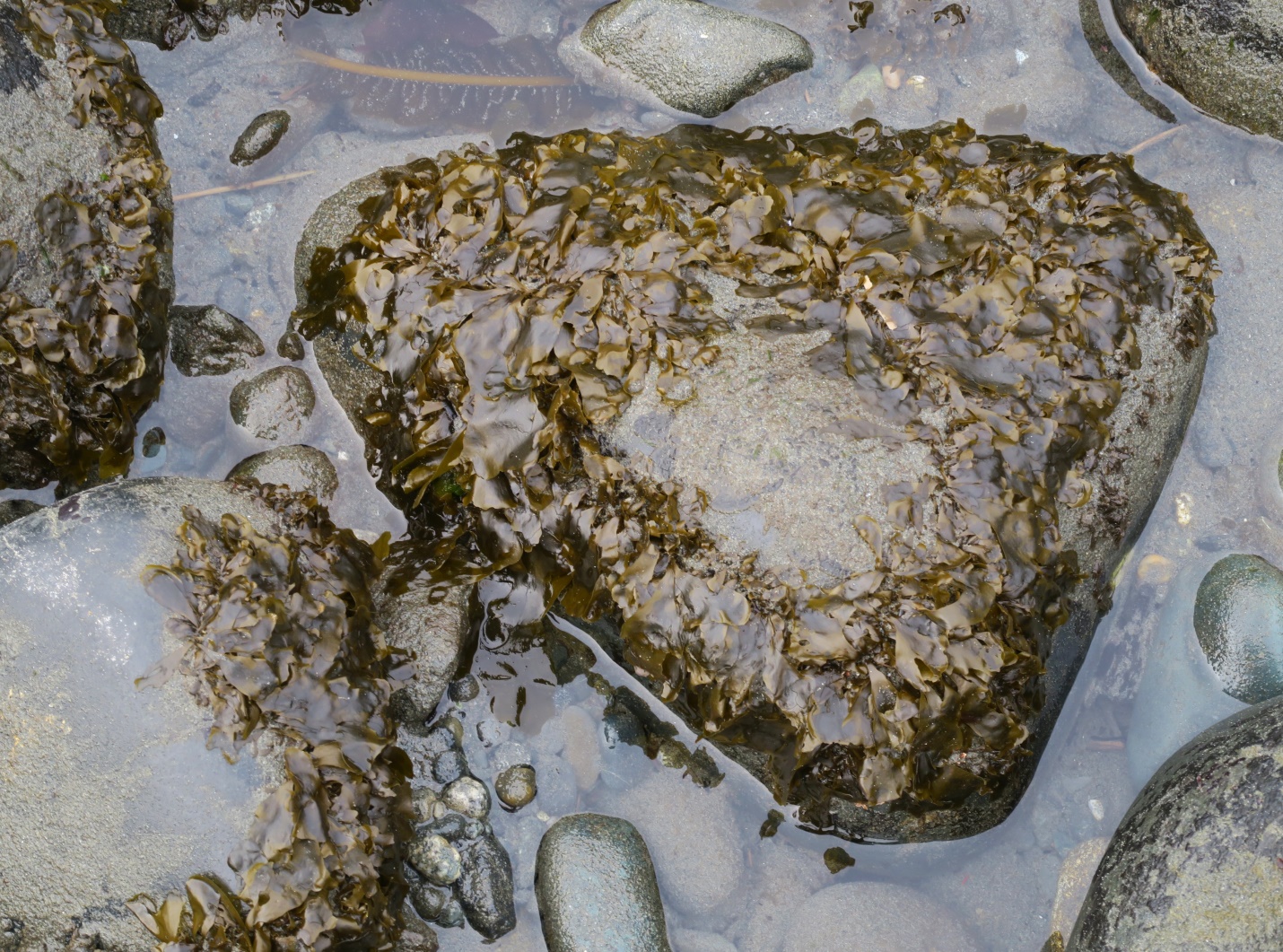
Figure 1: A set of moderate sized cobbles are shown here with a new growth of Phaeostrophion irregulare. The sand has been pulled off shore expose the perennial holdfasts and triggering a season of new blade growth. French Beach, Juan de Fuca Strait, B.C., Canada. March 17, 2023. Photo ID 27562 ©Seaweedwhisperings.com
Person 1:
Easily beaten up, but can rebound.
Can shine, then withdraw.
Safe from competition.
Blades are the “reaching out” aspect; the crust is the stability and safety.
Layers of blades in no apparent order create confusion.
Unsure of whether it wants to be exposed (out in the world) or sand-covered (out of view to others).
Easily offended; calling it “false” [as in False Kelp] is an affront.
Safety in numbers; individuals can easily hide within the group. They all pretty much look and behave the same.
Can explode in anger, and then retreat to safety where they can’t suffer repercussions.
I thought about whether this seaweed has a ‘double life’, but no..., it is more testing and trying than retreating.
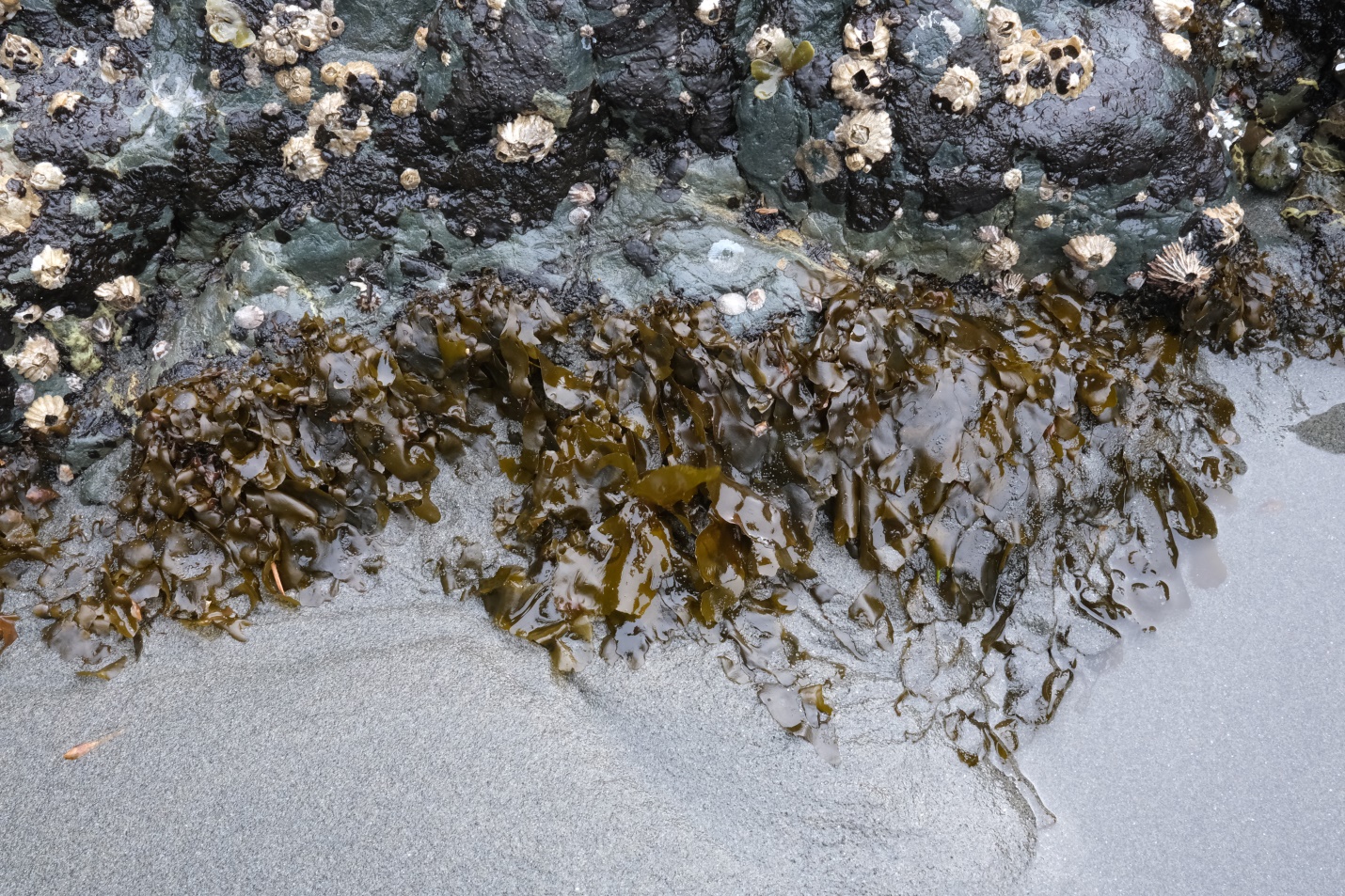
Figure 2: Growing in a cluster where the rock meets the sand are many blades of Sand-scoured False Kelp; some are partially buried, others are fully buried and a few present as the irregular-shaped brown kelp colored brown blades that are plainly visible at this tide. Fishboat Bay, Juan de Fuca Strait, B.C., Canada. April 20, 2022. Photo ID 27563 ©Seaweedwhisperings.com
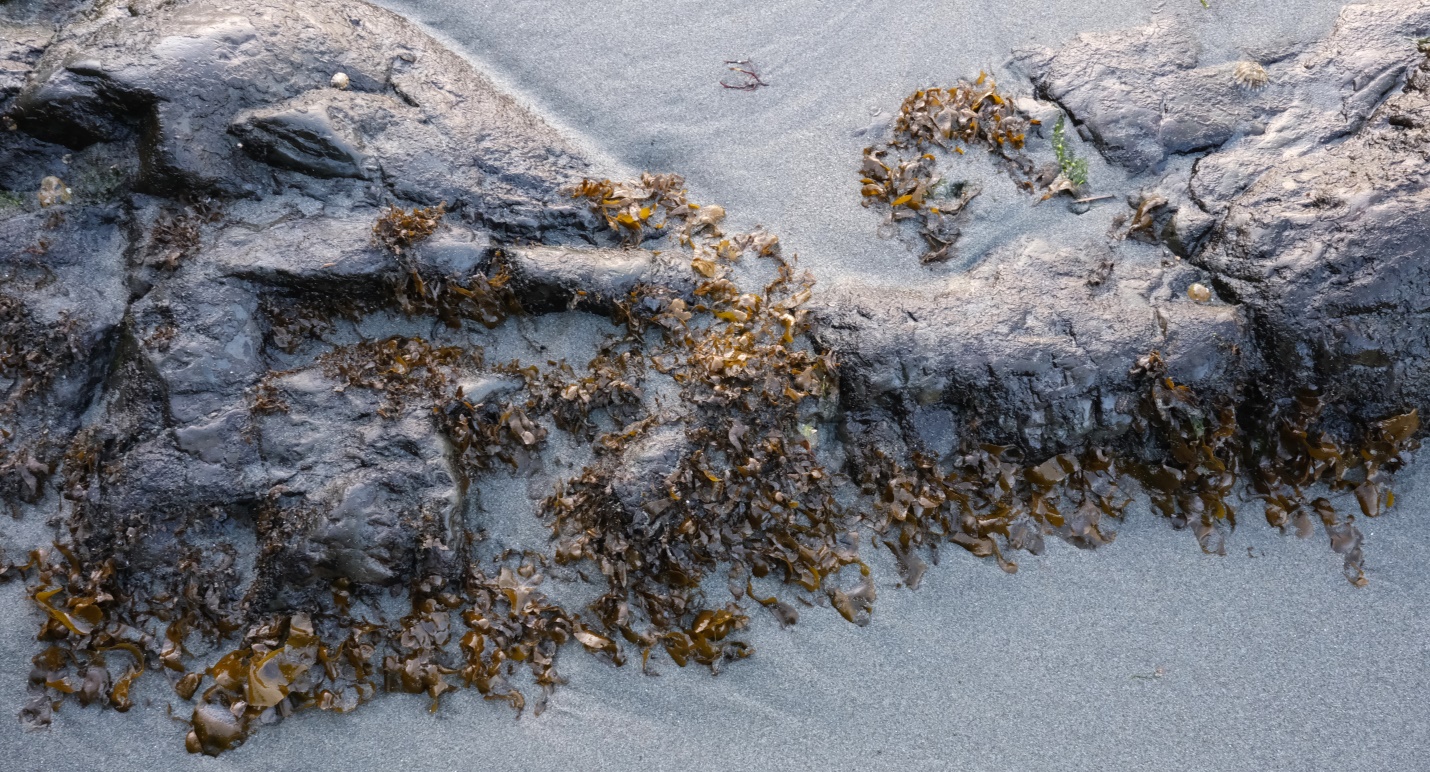
Figure 3: The expanse of rock viewed here is about 2 or 2.5 meters wide. There is quite an expanse of Sand-scoured False Kelp growing on it; the look is rather like “leaf litter” – fallen leaves blown up against a street side curb in autumn. Not natural debris, but a healthy seaweed, Phaeostrophion irregulare is at this season nearing its maximum size. Fishboat Bay, Juan de Fuca Strait, B.C., Canada. August 11, 2022. Photo ID 27564 ©Seaweedwhisperings.com
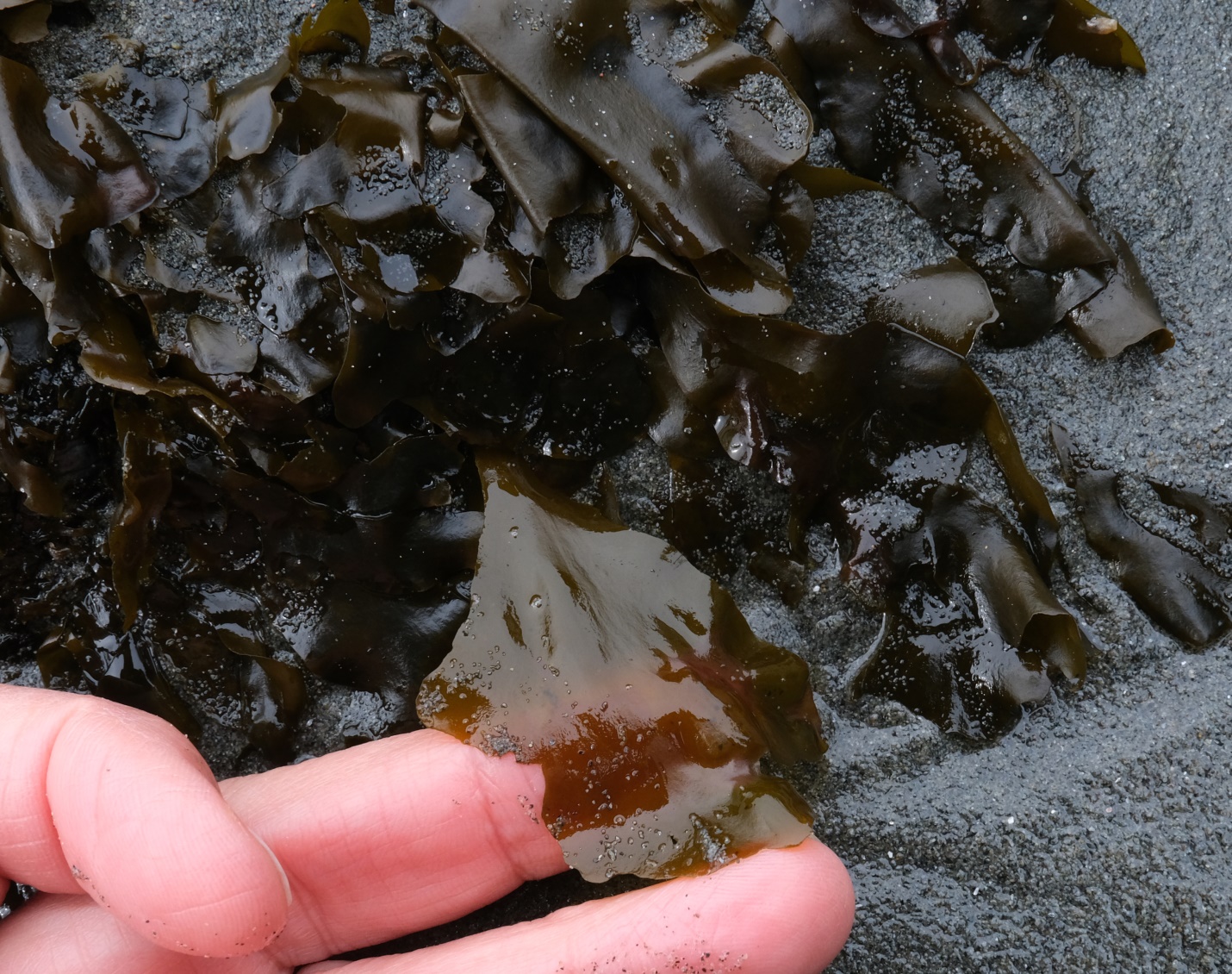
Figure 4: New blades are growing seemingly “out of” the sand. At this fresh and young age the margins and tips of the blades are not yet tattered or sand-abraded; they do however already have an ‘irregular’ outline. Fishboat Bay, Juan de Fuca Strait, B.C., Canada. April 20, 2022. Photo ID 27565 ©Seaweedwhisperings.com
Person 2:
This is a brown alga.
It grows in clusters or groupings.
From a basal crust that is usually hidden and out of sight.
I tried to find a word to describe the blade shape and the best I’ve found is that it looks like thin “tongues” of algae, many with a slight sickle-shaped curve near the base.
When exposed, each blade lies flat on the ones beneath it.
Afloat and submerged the tongues “lap” at the water, all reaching out wherever they can and as far as they can.
The “brown” is the typical ‘kelp brown’ which is some blend of medium brown shades and olive greens.
Compared to the coloration of other algae, Phaeostrophion is drab. Drab like camouflage colors – designed to NOT draw attention.
In rather uncommon circumstances light can be seen shining through your blades, backlighting you, and then your warmer more golden caramel tones are revealed. You really don’t show your ‘warmer’ side much, Sand-scoured False Kelp; does that make you feel too vulnerable?
You live in a part of the intertidal zone where there is much wave action, and also where there is much sand nearby. You are accustomed to being pummeled by surf and also with having particles of sand thrown over and around you. “Accustomed to”..., yes, and I also think you depend on this. I was going to say you “relish” this, but I think it is more accurate to say you “depend on” this. The constant scouring and water action keeps you alive and constantly engaged; it also keeps you trimmed and tested. UNTIL the times you are buried completely by the shifting sand of your preferred habitat.
You don’t really shine, at least not like Bull Kelp blades or floats and stipes. No, instead you have more of a matte finish, somewhat satiny but mostly dulled matte.
Again, dull; dull, unobtrusive, nothing to catch the eye or that would be immediately calling attention to you.
You don’t have a stipe, don’t have a mid-rib, and you grow simply as flattened blades. There is a hint of veins, but I don’t think you even have veins. This is more a bit of patterning from the combination of your matte surface and the lengthwise “tug” out and away of the action of ocean waters on your flattened tongue-like blades.
In some areas you can really grow in large groupings, BUT this is mainly where few other algae dare to try to live.
As a part of the “landscape” of the low intertidal zone, you can be overlooked. There are brighter colors, for sure; there certainly are more eye-catching forms, and there are definitely far more prominent positions to grow from. Sand-scoured False Kelp you seem to pick the humble position, the one that mainly goes unnoticed. This seems to suit you well, because you do flourish here.
But at times is there not also some bit of dissatisfaction or resentment regarding your position that creeps into your being?
Maybe you don’t compete well in other areas, but you can do well in harsh conditions where few others can; still somehow this ability doesn’t quite satisfy your will.
Very early spring seems to be when you are very healthy, Phaeostrophion irregulare. Enough sand has been washed away to give you access to light, and as soon as that happens you respond. You then pour your might – considerable will and freshly fueled energy, into new growth at this time. You grab the moment and run with it as far as you can.
You rim the large and medium sized cobbles here at French Beach. Looking at you here, the expression came to mind – “between a rock and a hard place”. Does this fit you? I believe it does, and I want to explore that idea further, later...
In one location I saw some very young Phaeostrophion growing on a boulder and nearby was a mossy chiton. The frilly “moss” rimming the chiton looked somehow similar to the look of the cobbles that are trimmed with you, Sand-scoured False Kelp! In that way do you actually camouflage or disguise the true nature – size and shape, of the boulder you grow on? Yes, I believe you do.
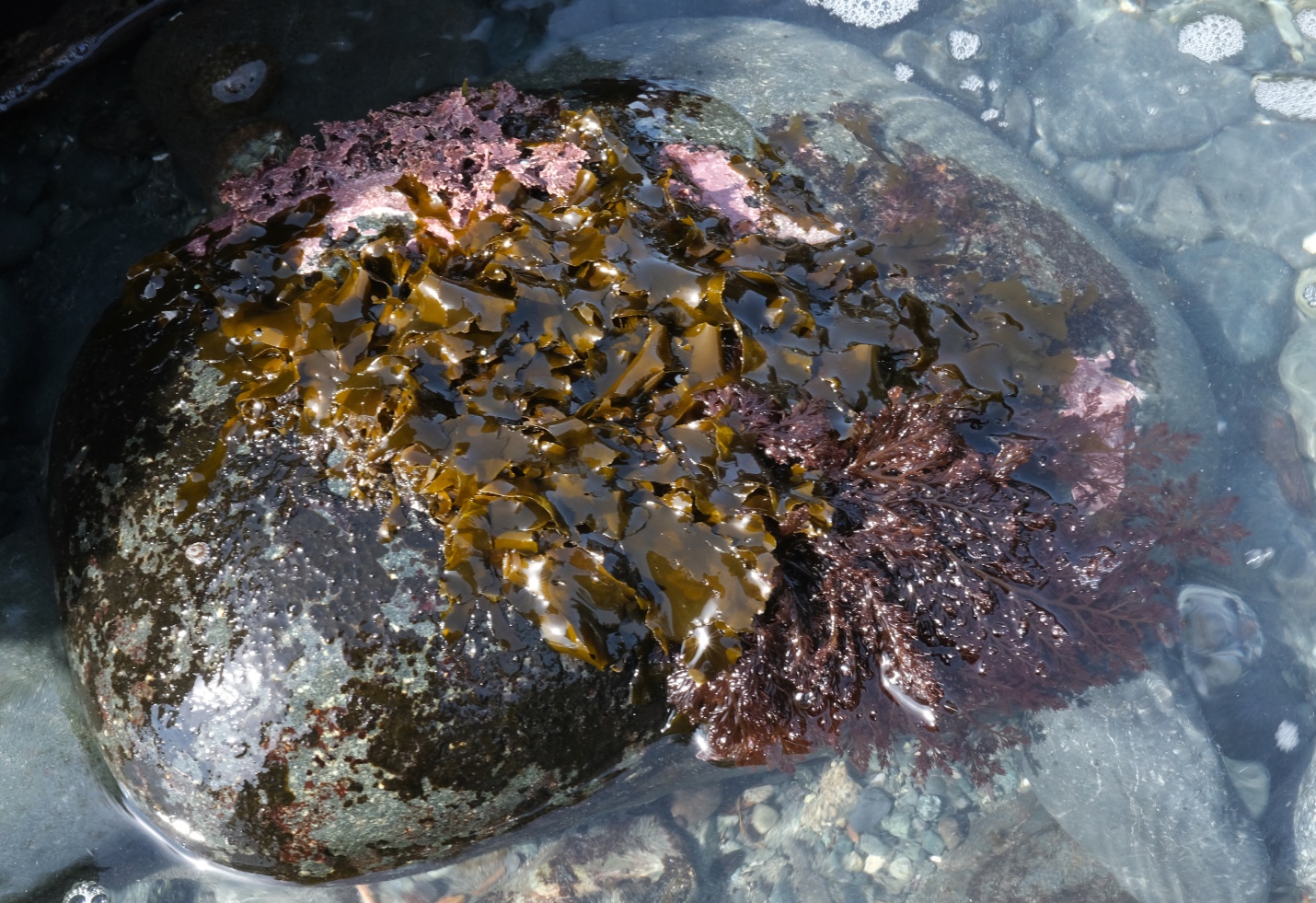
Figure 5: Clustered together on this large cobble, a group of Phaeostrophion irregulare stands out in contrast to the neighboring red algae with its “kelp brown” coloration. Smaller pebbles and sand surround the cobble and become instruments of abrasion to rock and algae alike when water conditions are right. French Beach, Juan de Fuca Strait, B.C., Canada. April 6, 2022. Photo ID 27566 ©Seaweedwhisperings.com
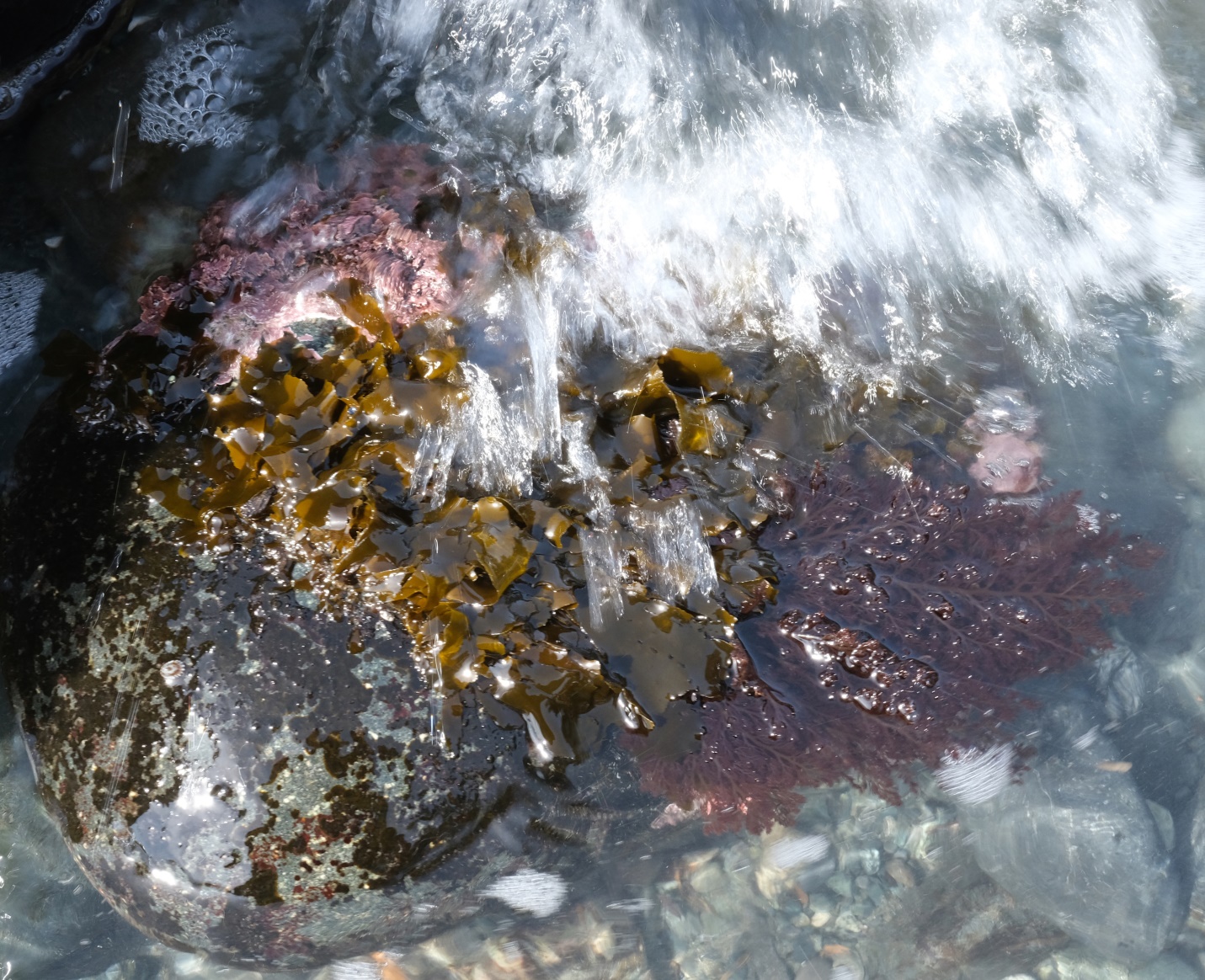
Figure 6: Water in action is sweeping the algae regularly at this tide level. Much greater wave action carries sand on shore and off shore seasonally; some years what is swept clear of sand is more extensive, other years only modest areas are freed from cover. It is not always guaranteed that Phaeostrophion irregulare will be visible and indeed, have the right conditions for another season of growth. An extensive perennial crustose holdfast ensures that at least some areas on most any year will meet suitable conditions for seasonal growth. French Beach, Juan de Fuca Strait, B.C., Canada. April 6, 2022. Photo ID 27567 ©Seaweedwhisperings.com
Discussion:
Not much emotion at the surface – in a way this fits with being called “false” kelp. We pondered how Phaeostrophion feels about the affront of being called “false” and we found that there was a sense of despair and helplessness in this. A sense of “but that’s not fair” (to call me that). Phaeostrophion fails to see that they contribute to the misunderstanding themselves with their hidden position and rather humble habits. We did not sense a ‘deliberate intent to deceive’ in this “false” kelp, but we also noted a lack of effort to correct any misinterpretations that arise.
Sometimes the unfairness of being called “false” is felt deeply enough that Phaeostrophion does express anger outwardly. Yet again, despite the expression of their feelings, internally they feel they can’t really do much about the issue. They stew and smolder over the unfairness and it wears them down, just as surely as the sand scouring wears down this seaweed.
There is some quality of uncertainty to the energy – i.e. show themselves or hide under the sand, and this may give a hint as to why this seaweed can be fittingly named “false kelp”. Uncertainty or hesitation in them seems to be linked to the newness of their abilities – these abilities are indeed present, but they’ve not been tested often enough or long enough to feel “proven”. Therefore, there is a strange mix of being very capable outwardly but inwardly feeling a level of confidence that is far lower.
Hiding is a fairly strong aspect of this seaweeds energy. Confusion created by blades going every which way certainly disguises any notable direction of their inner will. Hiding under seasonal deposits of sand also means there are times where any will is rendered ineffective – put into neutral or on pause for an interval of time. Do they feel “smothered” under a meter or two of sand, or do they embrace the period of dormancy that is imposed upon them?
That there is sand movement where they live is a given, but the unpredictability of this sand movement in their specific habitat works for Phaeostrophion irregulare. This seaweed can handle this, live with it, sometimes even do well with the unpredictability. This is not a common skill.
It felt to us that the seaweed itself may not actually know that they are doing well, but objectively (and in the view of most observers), it is clear that they are navigating exceptionally well the challenges of the unpredictable environment they call ‘home’. Probably these perpetually changing circumstances mean that Phaeostrophion must stay active in the moment to survive, and therefore there is little time to spare on evaluating how they’re doing. Perhaps this is why we sensed they don’t “shine” very often.
This seaweed grows in groupings but oddly each blade does not act as if part of a group. It’s “each blade for itself” (every man for himself) with this algae’s energy. We were surprised to recognize the striking sense of isolation each blade could have when growing so closely to its neighbors.
Hidden versus revealed – if anything is to be revealed by this seaweed it will only be at their discretion. This may be a key area where problems can arise, as Phaeostrophion tends to be overly cautious in this manner. Discretion may be the better part of valor, however, stating your true intentions and feelings at suitable intervals with appropriate individuals will go a long way towards furthering understanding and progress. This dynamic, of when to keep things hidden and when to reveal them, is one that Phaeostrophion struggles with finding and maintaining balance in.
“Explodes in anger” and the described “sickle shape” of blade..., both of these components hint that there may be some underlying aggression with this seaweed. Anger, cutting words, frustration and outrage, yes, but also not many real teeth. There is the indication that Phaeostrophion would back down fairly quickly in an altercation.
Also if they can explode in anger, we noted that they then will also retreat to safety where they avoid repercussions. In a way this is rather cowardly, this type of retreat. But their aggression is not a taunt; it is genuine if somewhat uncontrolled. It also then is mainly ineffective as there simply isn’t yet the certainty to power any corrective action or change as a result of their anger. It is also more typical that Phaeostrophion holds their outrage silently within; this of course builds up a backlog of emotion that occasionally, and somewhat surprisingly, will be vented.
“Caught between a rock and a hard place” – this expression came to mind for Phaeostrophion irregulare. It does seem that if this seaweed strives too far with its willful intent, well, then it gets routinely trimmed back down to size. The expression quoted above describes a situation where one is faced with two equally difficult alternatives AND a choice must be made between them. The feelings that can accompany this can include frustration, resentment and a type of paralysis that accompanies a sense of powerlessness. The solution would be to sink down into their own dexterous capacity of living well with unpredictability, thereby giving them access to wisely making the type of tough choice where it can seem that neither option is truly a “good” one. Sand-scoured False Kelp has seen enough dramatic changes of landscape to know that the future is always uncertain and therefore pragmatic action in the present time keeps their efforts firmly where they can be most effective.
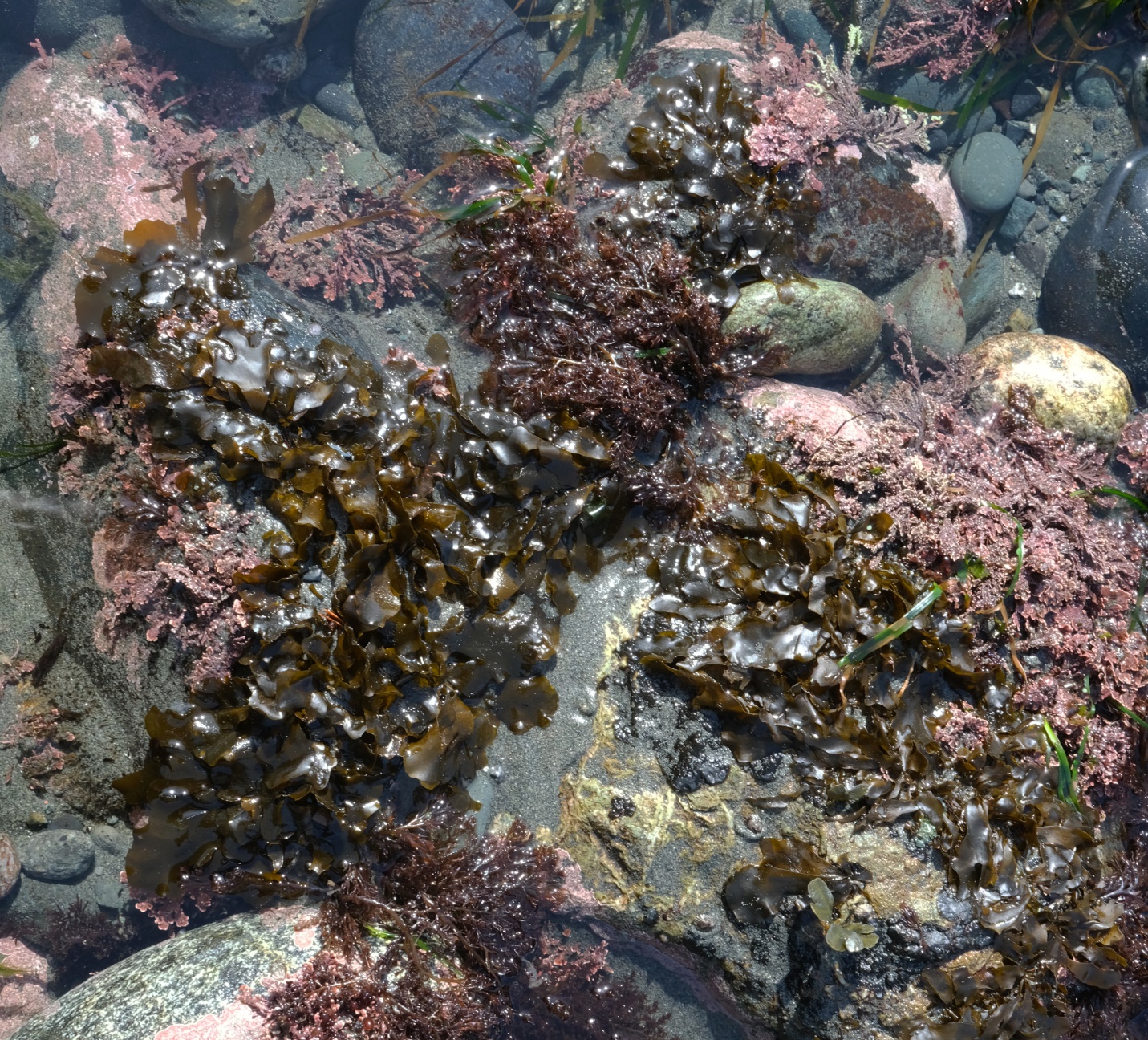
Figure 7: This cluster of large cobbles has an assortment of algae thriving in the intertidal zone. The rocks are now surrounded with sand that at certain seasons can cover them partially or bury them completely. French Beach, Juan de Fuca Strait, B.C., Canada. April 6, 2022. Photo ID 27568 ©Seaweedwhisperings.com
Biology & Natural History Information:
Description:
The thallus of this brown alga is composed of irregularly shaped medium tan to dark brown colored blades. The blades grow clustered together and are attached via a slender stipe to the seaweed’s encrusting and irregularly shaped holdfast; this holdfast is expansive and can reach up to 20 cm across. The blades which resemble small kelps can reach between 15 and 40 cm long and 1.5 to 4 cm wide and typically become worn and ragged looking as they age, particularly along the margins and near the ends.
Habitat:
This seaweed prefers to grow on rock embedded in sand in the mid to low intertidal and particularly in locations where it may seasonally become partially or fully buried in sand. Abrasion by sand can be considerable and gives the blades a worn, ragged or even tattered appearance. The holdfast is perennial. This seaweed is sometimes also found rimming tidepools. In the sand-swept habitats this seaweed can be buried under sand up to 2 meters deep. It can survive these anoxic conditions (lacking oxygen) for months on end. The sand trims and scours and at other times ‘suffocates’ this seaweed – a harsh set of conditions to be adapted to.
Pacific Coast Distribution:
Sand-scoured False Kelp grows from the Aleutian Islands and Yakutat Bay, Alaska, to Santa Barbara County, California.
Remarks:
This species is a member of the Order Spacelariales and has the common name of “False Kelp” due to its similarity in appearance to true kelp species. True kelps, however, compose a different taxonomic order, the Laminariales. This seaweed is the type species (holotype) of the genus Phaeostrophion. “Phaeostrophion” is from the Greek meaning brown twisted cord.
Classification:
Phylum: Ochrophyta
Class: Phaeophyceae
Order: Sphacelariales
Family: Phaeostrophiaceae
Genus: Phaeostrophion
Species: Phaeostrophion irregulare Setchell & N.L.Gardner 1924
Former name(s): This alga has not had a taxonomic revision that brought about any corresponding name changes, not once since its description by Setchell and Gardner in 1924. It is uncommon to have a seaweed “hold” its name and therefore have no former names or synonyms.
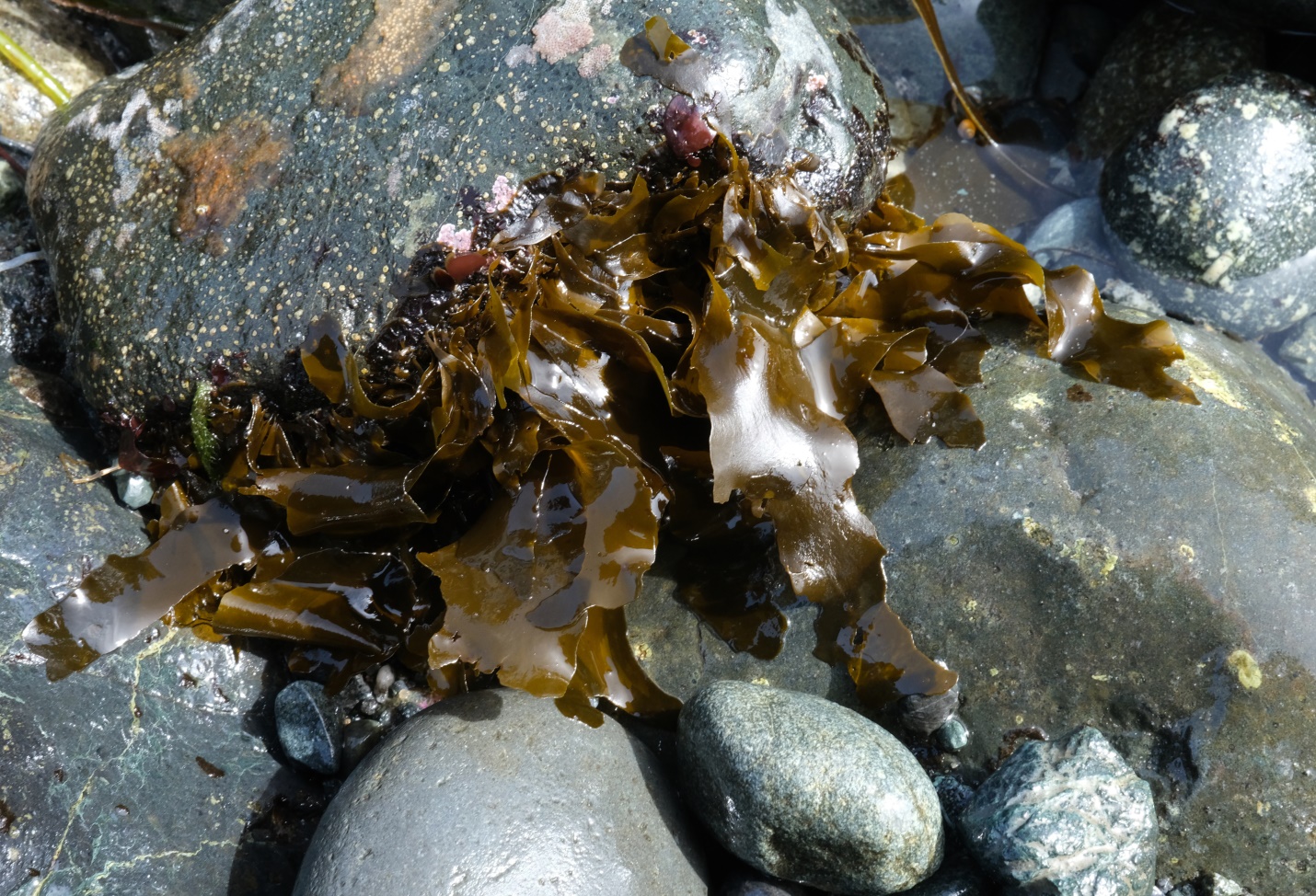
Figure 8: This cluster of Sand-scoured False Kelp is looking rather kelp-like indeed, and the exposed blades display their irregular and somewhat tattered form. French Beach, Juan de Fuca Strait, B.C., Canada. April 6, 2022. Photo ID 27569 ©Seaweedwhisperings.com
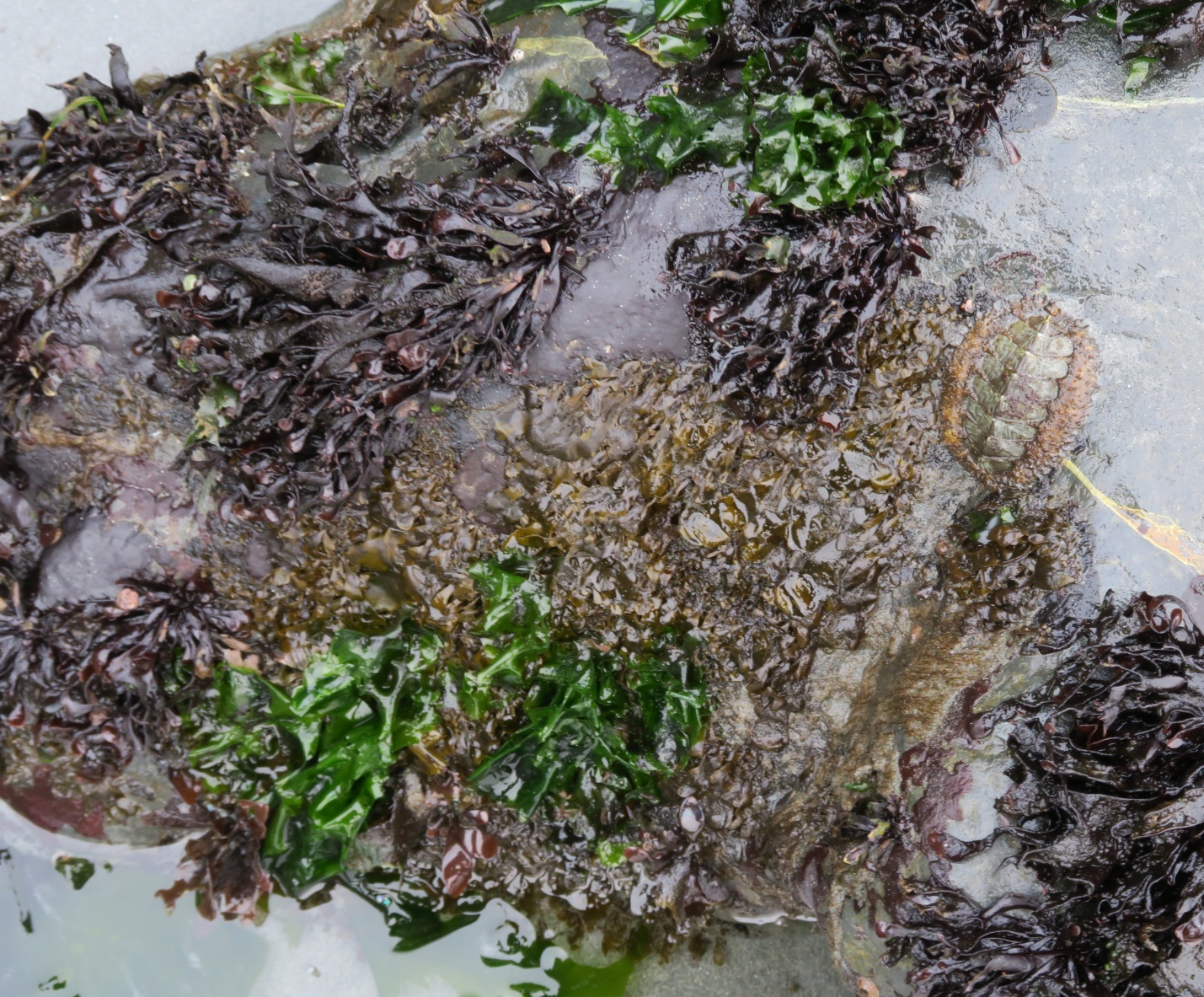
Figure 9: This sand-surrounded boulder has all three types of algae growing on it, red (Mastocarpus spp.), green (Ulva spp.) and brown – our species of investigation with this Whispering, some very young Phaeostrophion irregulare. About midway in in the photo and near the right perimeter, the herbivorous mollusk commonly called mossy chiton, Mopalia muscosa, is visible hugging the rock. The mossy girdle of the chiton is reminiscent of how some of the False-Kelp rimmed rocks looked – trimmed as they were with similar length and uniform colored brown algae. Flea Beach, Juan de Fuca Strait, B.C., Canada. March 17, 2023. Photo ID 27570 ©Seaweedwhisperings.com
![]()